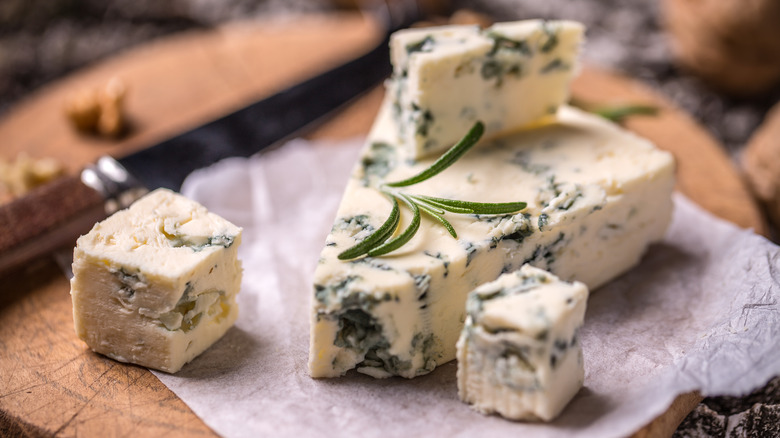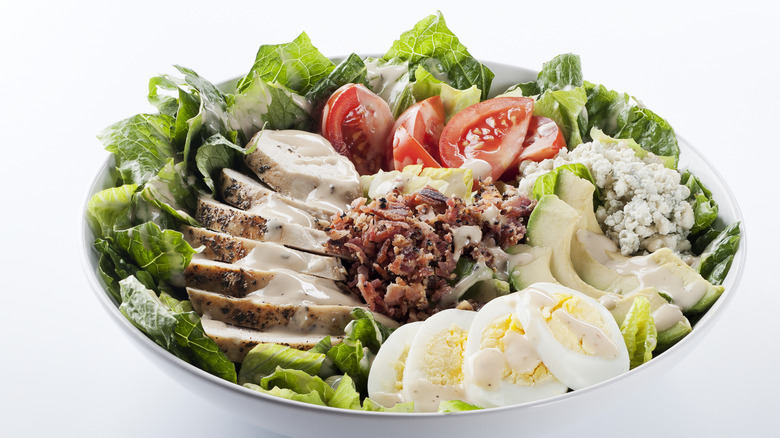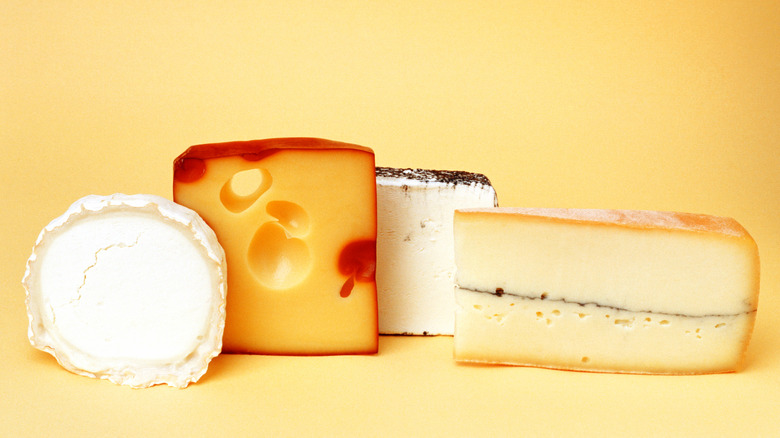The Best Blue Cheese Alternative For Those Intimidated By Mold
With its pungent flavor profile and signature ribbons of mold running throughout, blue cheese can be a polarizing ingredient: You either love it or you hate it. Cheeses in this category come in varying degrees of potency, and the strains of Penicillium mold throughout are safe for most people to eat, even some folks with penicillin allergies. Still, some of us just aren't sold on eating mold, and this style of cheese can be surprisingly hard to avoid. Whether you're craving buffalo wings, a classic Cobb salad, or a cheese plate, blue cheese is likely to make an appearance in your meal (or it will at least be a suggestion).
Of course, you can cook or order your meal sans blue cheese, but removing such a potent ingredient can create a sensation of something missing in the final dish. Thankfully, you can use other cheeses to add a similar flavor and texture. Flavorful cheeses like feta, cheddar, or strong goat cheese, and creamy ones like ricotta and cream cheese, can help you create a similar overall experience, without having to eat blue cheese at all.
How to use other cheeses in place of blue cheese
When choosing a replacement for blue cheese, consider what characteristics the cheese is meant to add to a recipe, and what options might mimic those textures and flavors. In salads and pastas, gorgonzola or Roquefort are common blue cheese choices. The former is on the dryer, more crumbly side, with a mild flavor and salty finish, so feta is a great mold-free replacement. Roquefort has a tangy, peppery, sharper flavor and a creamy texture, so try using a moist yet strongly-flavored goat cheese in its place. Finish your dish with fresh cracked black pepper to match Roquefort's subtle bite.
If you're making a dip, dressing, or spread, choices like feta, goat cheese, or even a sharp aged cheddar will be your best bet for replicating a funk similar to blue cheese. Chop, grate, or crumble the cheese to a similar consistency as the blue cheese called for in your recipe, whether it be a firmer or softer variety. Fresh cheeses like ricotta or cream cheese, or even sour cream, will work to bolster creaminess in your mold-free creation. They add a subtle tang, but no strong, distracting flavors.
If these cheeses don't produce the intensity of flavor you're after, consider experimenting with fermented Chinese bean curd. This product is sometimes called "tofu cheese" because of its fermented flavor and creamy texture. A little goes a long way, and some vegan cooks use it as a dairy-free substitute for blue cheese.
Moldy cheeses for curious beginners
If you're put off by the moldy blooms in blue cheese, you're not alone, but some of us might actually wish we liked mold a little more. Many other cheeses besides the blues — not to mention countless dry-cured meats — use bacteria or fungus to achieve their distinct flavors. Feel like you're missing out? Much milder "moldy" foods can help you warm up to the concept.
To make blue cheese, mold strains like Penicillium roqueforti (which is used in Roquefort, naturally) are injected into the curds in a process called interior mold ripening. But surface ripening with strains like Penicillium camemberti and Geotrichum candidum is another common practice, producing a mild external coating that may be white, orange, or yellow. These moldy yet inoffensive rinds are essential to producing easy-to-like cheeses like Brie and camembert – the latter of which might be going extinct, so try it while you can.
While eating dangerous molds can cause a variety of unpleasant effects, consuming the carefully-monitored strains used to make cheese can actually improve gut health and your internal microbiome. Ease into this exciting and delicious world with a soft, buttery triple-creme Brie, or perhaps an ash-ripened cheese. These types use wood ash to facilitate the growth of edible mold, creating a delightfully dramatic appearance with complex flavors. To go just a step further, try Bleu d'Auvergne, a blue that's incredibly mild thanks to the type of mold used, Penicillium glaucum.



